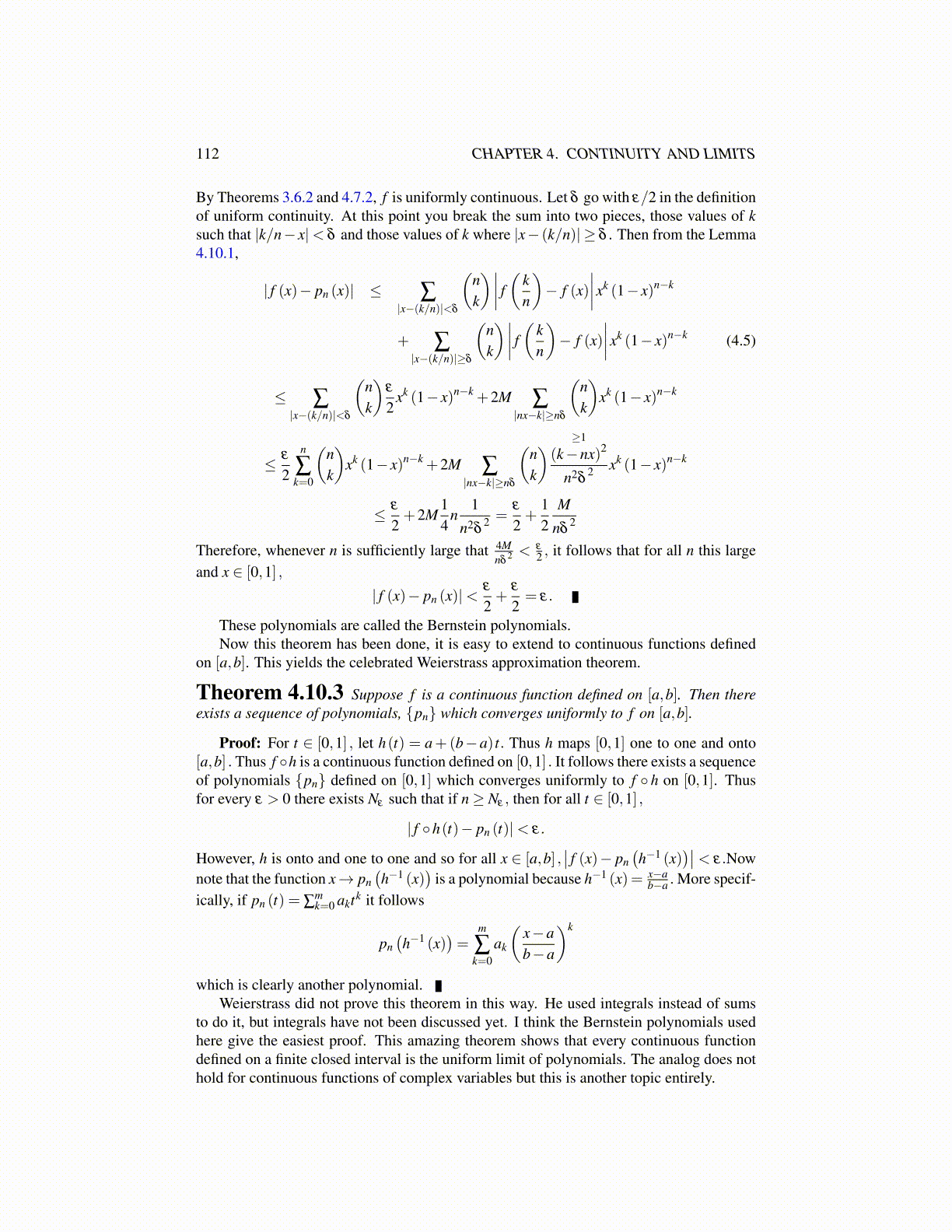
112 CHAPTER 4. CONTINUITY AND LIMITS
By Theorems 3.6.2 and 4.7.2, f is uniformly continuous. Let δ go with ε/2 in the definitionof uniform continuity. At this point you break the sum into two pieces, those values of ksuch that |k/n− x|< δ and those values of k where |x− (k/n)| ≥ δ . Then from the Lemma4.10.1,
| f (x)− pn (x)| ≤ ∑|x−(k/n)|<δ
(nk
)∣∣∣∣ f ( kn
)− f (x)
∣∣∣∣xk (1− x)n−k
+ ∑|x−(k/n)|≥δ
(nk
)∣∣∣∣ f ( kn
)− f (x)
∣∣∣∣xk (1− x)n−k (4.5)
≤ ∑|x−(k/n)|<δ
(nk
)ε
2xk (1− x)n−k +2M ∑
|nx−k|≥nδ
(nk
)xk (1− x)n−k
≤ ε
2
n
∑k=0
(nk
)xk (1− x)n−k +2M ∑
|nx−k|≥nδ
(nk
) ≥1
(k−nx)2
n2δ2 xk (1− x)n−k
≤ ε
2+2M
14
n1
n2δ2 =
ε
2+
12
M
nδ2
Therefore, whenever n is sufficiently large that 4Mnδ
2 < ε
2 , it follows that for all n this largeand x ∈ [0,1] ,
| f (x)− pn (x)|<ε
2+
ε
2= ε.
These polynomials are called the Bernstein polynomials.Now this theorem has been done, it is easy to extend to continuous functions defined
on [a,b]. This yields the celebrated Weierstrass approximation theorem.
Theorem 4.10.3 Suppose f is a continuous function defined on [a,b]. Then thereexists a sequence of polynomials, {pn} which converges uniformly to f on [a,b].
Proof: For t ∈ [0,1] , let h(t) = a+(b−a) t. Thus h maps [0,1] one to one and onto[a,b] . Thus f ◦h is a continuous function defined on [0,1] . It follows there exists a sequenceof polynomials {pn} defined on [0,1] which converges uniformly to f ◦ h on [0,1]. Thusfor every ε > 0 there exists Nε such that if n ≥ Nε , then for all t ∈ [0,1] ,
| f ◦h(t)− pn (t)|< ε.
However, h is onto and one to one and so for all x ∈ [a,b] ,∣∣ f (x)− pn
(h−1 (x)
)∣∣ < ε.Nownote that the function x→ pn
(h−1 (x)
)is a polynomial because h−1 (x)= x−a
b−a . More specif-ically, if pn (t) = ∑
mk=0 aktk it follows
pn(h−1 (x)
)=
m
∑k=0
ak
(x−ab−a
)k
which is clearly another polynomial.Weierstrass did not prove this theorem in this way. He used integrals instead of sums
to do it, but integrals have not been discussed yet. I think the Bernstein polynomials usedhere give the easiest proof. This amazing theorem shows that every continuous functiondefined on a finite closed interval is the uniform limit of polynomials. The analog does nothold for continuous functions of complex variables but this is another topic entirely.